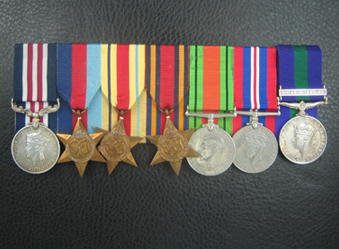
MILITARY MEDAL, G.VI.R. ‘10741 HAV. GOLABA RAM, PUNJAB R.’, 1939-45 STAR; AFRICA STAR; BURMA STAR; DEFENCE AND WAR MEDALS 1939-45; GENERAL SERVICE 1918-62, 1 CLASP, S.E. ASIA 1945-46 ‘10741 HAV. GULABA, 3-2 PUNJAB R’.
M.M. London Gazette 20 September 1945.
The original recommendation, for an immediate award, states:
‘On the night of 6-7 May 1945, at Abya, Havildar Golaba Ram’s company was heavily attacked by a large party of Japanese supported by medium machine-guns and other automatic weapons for a period of three to four hours. The attack was entirely against the front of one platoon, of which this N.C.O. was the Platoon Havildar, and shortly after the beginning of the action, the Subedar commanding it was killed. Havildar Golaba Ram at once took control of the Platoon, which was then being hard pressed and, in spite of heavy enemy fire from close range, went to his foremost sections steadying them and cooly directing their fire. Later in the action, finding his platoon reduced by casualties, he himself went to and fro to his sections regardless of the fire, keeping them supplied with ammunition and taking his place in the line wherever the threat was greatest. The attack was beaten off and at daybreak 13 bodies were recovered from the Platoon’s front. This N.C.O’s courage under heavy fire and coolness in an emergency were a steadying example to his men at a critical time and contributed to his company’s success in the action.’
Golaba Ram was a Dogra Jat from Kangar village in Balaspur State. Prior to his M.M.-winning exploits in Burma, he saw action as a Sepoy in the 3rd Battalion, 2nd Punjab Regiment in Eritrea, and was wounded in his unit’s first action, at Gocni, on 26 January 1941. He saw later service during the operations in South-East Asia 1945-46.
The 3rd Battalion, 2nd Punjab Regiment, saw extensive service in a number of theatres during the WW2. As part of the 29th Indian Brigade, 5th (Ball of Fire) Indian Division, they served in the Sudan from mid 1940, taking part in the Abyssinia campaign before moving to North Africa, where they fought until September 1942. Next they were serving with PAIFORCE and were based at Quetta Camp, east of Bagdhad but by June 1943 they were back in India training for jungle warfare. In November 1944 they went into action in the Arakan, before being rushed to the aid of the Kohima garrison, afterwards fighting their way through the Chin Hills and on to Meiktila in March 1945. Fighting at Tatkon, the battalion captured Pyinmana on 21 April and from there were detached from their Division, advanced to occupy Kokpalin ferry crossing on the Sittang River. It was for his actions at Abya in resisting Japanese attacks on 6-7 May 1945, that Havildar Golaba Ram would be awarded the Military Medal. After the war in Burma, the battalion had a brief break from Active service, before landing on Java in November 194. Here the participated in the Indonesian campaign, before leaving for India on 5 May 1946.
The 2nd Punjab Regiment battle honours for WW2 are as follows: Keren, Ad Teclesan, Amba Alagi, Abyssinia 1940–41, Central Malaya, Ipoh, Singapore Island, Malaya 1941–42, North Africa 1940–43, Casa Bettini, Italy 1943–45, Buthidaung, Ngakedaung Pass, North Arakan, Imphal, Litan, Kanglatongbi, Tengnoupal, Tonzang, Kennedy Peak, Defence of Meiktila, Pyinmana, Burma 1942–45.
Condition, generally GVF. Sold with copied research, including details of the unit, maps, recommendation etc.